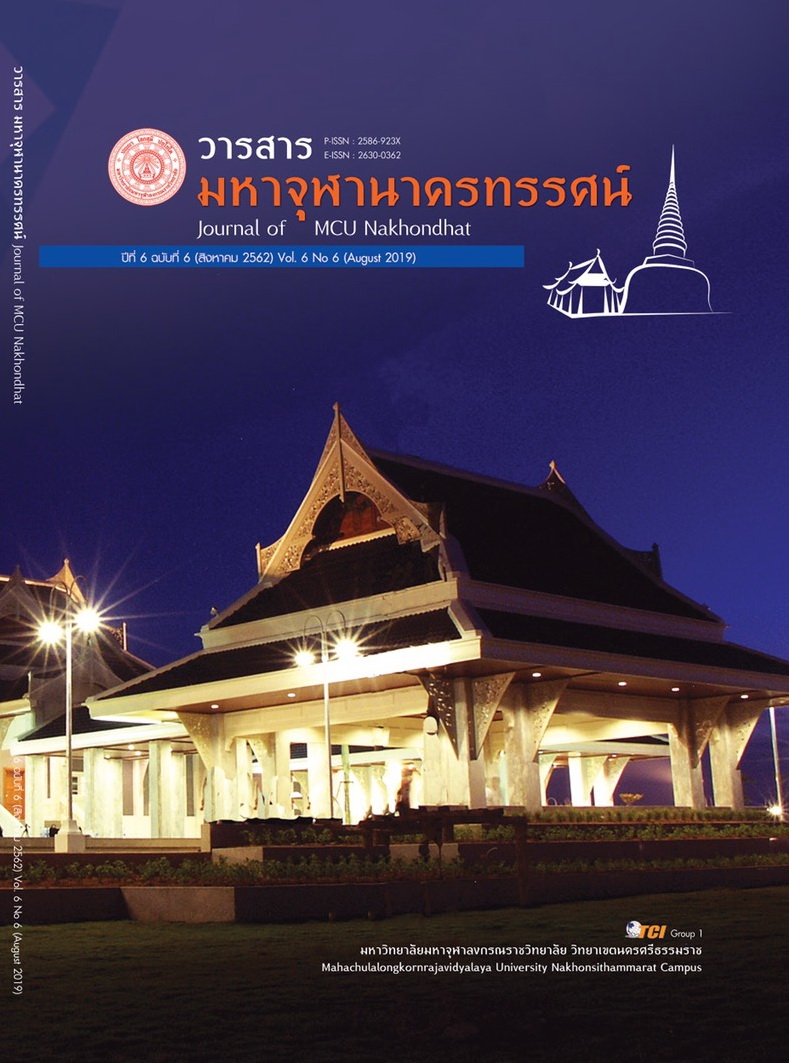THE DEVELOPMENT OF THAI LANGUAGE INSTRUCTIONAL MODEL FOR ENHANCING READING LITERACY AND COMMUNICATION FOR STUDENTS OF PRIMARY SCHOOL GRADE 6
Main Article Content
Abstract
The purposes of this research were 1. To study the stages of teaching process and strategies of learning Thai language to improve reading literacy and communication 2. To develop the model of teaching and learning Thai and improve reading literacy and communication, and 3. to evaluate the model of teaching Thai to improve reading literacy and communication for the students of primary school sixth grade. This research is mixed methods research as developed groups of people from 30 students of primary school sixth grade Watthungkha school in Songkhla primary educational service area office two, Thai teachers, executive directors of school in affiliated with Kamphaeng Phet from nine schools, and educational supervisor in Songkhla primary educational service area office two by selected from specific person (Purposive Selection). The data were grained from analysis and synthetic documents including with strategy and the teaching methods to improve reading literacy and communication. Next step, test and evaluate student progress of reading literacy and communication. Afterward survey of student’s satisfaction and people who joined this program. the analyze data from percentage, average, standard deviation, and t-test dependent
The results indicated as following details
the structure of teaching methods to improve reading literacy and communication, there were 6 topics 1. theory, principles of idea 2. the purpose 3. content of course 4. teaching and learning methodology 5. teaching techniques, and 6. evaluation of learning strategies. 2. Teaching Thai to improve reading literacy and communication, there were 4 topics 1. intelligence strategy 2. Knowledge strategy 3. relationship building strategies 4. strategies of improving communication skills. Moreover, Stages of teaching Thai to improve reading literacy and communication, there were 4 steps 1. Check prior knowledge: C 2. Arouse interest: A 3. Reading activities: R 4. Evaluation: E.; all of 4 steps called CARE Model. the results of this model to students of primary school sixth grade was indicated that students have higher scores after followed this program. The significance at the .05 level. The result of learning Thai languages after followed the program higher than before. The satisfaction of students and people who joined this program in high level. This program was evaluated a quality by professionals with high level.
Article Details
References
กิตติยาวดี บุญซื่อ. (2548). รายงานการสังเคราะห์รูปแบบการพัฒนาครูทั้งโรงเรียน ประสบการณ์จากโรงเรียนในโครงการปฏิรูปการเรียนรู้เพื่อพัฒนาคุณภาพผู้เรียน. กรุงเทพมหานคร: พิมพ์ดีการพิมพ์จำกัด.
ทิศนา แขมมณี. (2548). ศาสตร์การสอน:องค์ความรู้เพื่อการจัดกระบวนการเรียนรู้ที่มีประสิทธิภาพ (พิมพ์ครั้งที่ 8). กรุงเทพมหานคร: สำนักพิมพ์จุฬาลงกรณ์มหาวิทยาลัย.
นิลรัตน์ นวกิจไพทูรย์. (2561). การพัฒนาสมรรถนะผู้เรียนโดยใช้กระบวนการวิจัยวารสาร. นาคบุตรปริทรรศน์ มหาวิทยาลัยราชภัฏนครศรีธรรมราช, 9(1).
พัชรี ทองเรือง,ปัญญา เลิศไกร และ กันตภน หนูทองแก้ว. (2560). รูปแบบชุมชนแห่งการเรียนรู้ที่ยั่งยืน. นาคบุตรปริทรรศน์ มหาวิทยาลัยราชภัฏนครศรีธรรมราช, 9(2).
รัตนะ บัวสนธ์. (2556). วิธีการเชิงผสมผสานสำหรับการวิจัยและประเมิน (พิมพ์ครั้งที่ 2). กรุงเทพมหานคร : สำนักพิมพ์แห่งจุฬาลงกรณมหาวิทยาลัย.
ลออ คันธวงศ์. (2551). ผลการใช้กิจกรรมพัฒนาการอ่านเพื่อความเข้าใจด้วยนิทานพื้นบ้าน สำหรับนักเรียนชั้นประถมศึกษาปีที่ 4. ใน วิทยานิพนธ์ครุศาสตร์มหาบัณฑิต สาขาหลักสูตรและการสอน. มหาวิทยาลัยราชภัฏลำปาง.
วรัญญา โอภาษี. (2554). การใช้กลวิธีความรู้ความเข้าใจและกลวิธีทางสังคม เพื่อส่งเสริมความสามารถในการฟัง พูดภาษาอังกฤษ และลดความวิตกกัวลในชั้นเรียนของนักศึกษาปริญญาตรี. ใน วิทยานิพนธ์ศึกษาศาสตรมหาบัณฑิต สาขาวิชาการสอนภาษาอังกฤษ. มหาวิทยาลัยเชียงใหม่.
ศักดา กะแหยมเตบ นพรัตน์ ชัยเรือง และประยงค์ ชูรักษ์. (2561). แนวทางการพัฒนางานวิชาการเพื่อยกระดับผลสัมฤทธิ์ทางการเรียนของสถานศึกษา ในสังกัดเขตพื้นที่การศึกษาประถมศึกษานครศรีธรรมราช เขต 2. นาคบุตรปริทรรศน์ มหาวิทยาลัยราชภัฏนครศรีธรรมราช, 10(2).
สุภางค์ จันทวานิช. (2557). วิธีการวิจัยเชิงคุณภาพ (พิมพ์ครั้งที่ 22). กรุงเทพมหานคร: สำนักพิมพ์แห่งจุฬาลงกรณ์มหาวิทยาลัย.
หนึ่งฤทัย วามตา. (2554). การใช้กลวิธีการอ่านแบบร่วมมือร่วมกับสื่อสภาพจริงเพื่อส่งเสริมความเข้าใจในการอ่านภาษาอังกฤษและแรงจูงใจของนักศึกษาระดับประกาศนียบัตรวิชาชีพชั้นสูง. ใน วิทยานิพนธ์ศึกษาศาสตรมหาบัณฑิต สาขาวิชาการสอนภาษาอังกฤษ. มหาวิทยาลัยเชียงใหม่.
Joyce, B.R., & Weil, M. (2000). Models of Teaching (6th ed). Massachusetts: Allyn & Bacon.
O’Malley, J. M. & Chamot, A. U. (1990). Learning strategies in second language acquisition. Cambridge: Cambridge University Press.
Oxford, Rebecca. (1990). Language Learning Strategies: What Every Teacher Should Know. New York: Newbury House Publishers.
Wenden, A & Rubin, Joan. (1987). Learner Strategies in Language Learning. New Jersey: Prentice Hall.

